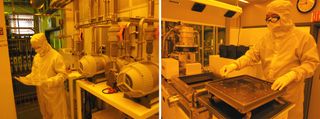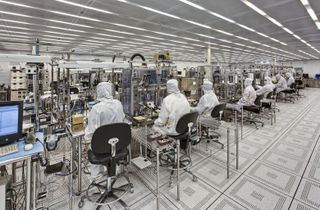Inside Western Digital: How Tomorrow's Storage Gets Made
Odds And Ends

There was so much ground to cover in these facilities that I’m only showing you the barest fraction of what we saw. I’ve tried to focus here on some of the more cutting-edge, high-ticket machinery that showcases just how much a company like Western Digital has to ride on the nano-scale edge of R&D to keep the industry advancing. Of course, in any operation of this size, not everything can be ultra-impressive. In this image on the left, for example, a fab operator stands near the bake ovens used to cure photoresist (photo-sensitive) chemicals. I just thought those turbine-ish looking things seemed cool.
In the photo on the right, an operator loads wafers into a PVD tool. These particular wafers are about to receive their alumina overcoat layer. This is the last (top) layer covering the entire head, and it serves to protect the head from ambient environments. But what caught my eye was how the tech was wearing his glasses in a way you never could without that suit pinching your head. Funny, I thought, all the little ways employees adapt to their tasks in this bizarre place.
If you can handle a little Blair Witch-style footage, I have this clip for you. It might give you some idea of just how large and sprawling WD’s cleanroom facilities are.
The Lucky Winner

I applaud any company that understands and values philanthropy, particularly in a down economy. WD makes it a priority to give back to the surrounding communities in which it operates through the Western Digital Charitable Foundation. The Foundation’s philanthropic budget goes to education (40%), health and human services (40%, including to at-risk youth), and civic and community efforts (20%). Most of the Foundation’s budget derives from the company’s annual performance, but employees also kick in monetary donations as well as their time on community volunteer projects.
One popular fundraiser is the annual parking lot raffle, which raises money for a local food bank. It seems that parking is ridiculously tight at the Magnetic Head Facility. WD has to procure special street parking permits from the city of Fremont and actually rents parking space from the adjacent gas station. So scoring a private, dedicated parking spot right between both entrances to the facility’s two main buildings is no small prize.
Preparing For The Real World

We’ve seen WD’s R&D setup for media and read/write heads. Eventually, all of the tiny tech has to emerge and function in the macroverse. That’s where our third and last facility, the pilot line, comes into play. This is where drives get assembled in yet another cleanroom facility, then tested until they (hopefully don’t) drop. If everything goes as planned here and no flaws are found in the production process, then drives and their components get approved to enter mass production in Asia.
Assembly Line

As you might expect, this is a view in miniature of the armada of assemblers WD employs in Malaysia and Thailand. The goal of this crew is to make enough drives to represent a statistically significant number of units within any given new drive design. There are nine assembly stations down this line. The rest of the room is filled with additional desk stations filled with various types of test equipment.
Stay on the Cutting Edge
Join the experts who read Tom's Hardware for the inside track on enthusiast PC tech news — and have for over 25 years. We'll send breaking news and in-depth reviews of CPUs, GPUs, AI, maker hardware and more straight to your inbox.
For those who have never seen how a hard drive goes together, we thought the following set of shots might be interesting.
Drive Assembly 1

There’s not much to say here. If you’re familiar with hard drive anatomy, then you know how the base assembly mounts the spindle, which holds the platters, and so on. In the second frame, you can see the mounting of part of the voice coil actuator, the motor unit that moves the arms over the platter surfaces. That little arc in the piece contains a magnet that interacts with a coil in the arm assembly to control the arms’ movements.
Drive Assembly 2

Because the read/write head and arm assembly is so precise and delicate, it’s handled by an automated robotic machine (left image). In the right image, you can see the special screwdriver used by the assembly techs. The screwdriver uses a precise amount of torque and is immune from dropping screws. I so want one of these for my garage.
Note: truth be told, we photographed this sequence backwards, starting with an assembled drive and then stripping it down. If you want to see some of the process in action, check out this clip.
Behold Excalibur!

Drives exit the assembly room in a small crate and pass along a conveyor belt. From here, drives can get routed to any of several areas and machines for long-term testing. One such test machine is called Excalibur. In the picture on the right, you can see an operator feeding a drive onto Excalibur’s conveyor belt. That object behind the glass just above head level is Excalibur’s robotic arm. The robot grabs the drive and whisks it back down the aisle you see behind it. The drive gets inserted into a bay, whereupon its media is filled with a servo pattern to fill the tracks with data. This will confirm that all of the media is able to store information.
Excalibur can hold about 5,000 drives. We saw other smaller test units, but WD needs Excalibur to handle the location’s volume. At any given time, there are usually several experimental models in Excalibur’s test ranks, both 2.5- and 3.5-inch. The machine cranks through several tens of thousands of drives annually.
While we’re seeing WD’s test procedures on pilot line drives here, know that the exact same tests are applied to the production lines in Asia. Even though WD manufactures over half a million drives per day (the company reported almost 50 million produced in Q4 of 2009), each one goes through an Excalibur system and testing process just like these relative few.
The Other Future

Before leaving the pilot line facility, we made a quick stop in this room, where we found a test engineer poring over NAND memory, examining the performance and reliability of individual chips. With the company now throwing its hat in the SSD ring, you can see that it isn’t simply putting its own sticker on someone else’s drive. Engineers on this test bed look at different blocks of the NAND, running different endurance tests, and seek to determine the limits of both SLC and MLC designs. They’re looking for failures per sector. See that red dot on the green checkerboard? That’s a failed cell. Once the cell is located, subsequent testing zooms in to hopefully find out why the cell failed and work toward a remedy.
The column you see to the left of the test platform is an environmental chamber that can swing over and encase the test subject, allowing engineers to examine different performance characteristics under different conditions. A logic analyzer helps WD techs examine different current profiles and power consumption based on operations, such as reads and writes.
“Going to SSD doesn’t get rid of all the problems in storage,” said the WD engineer. “It just replaces the old problems with a set of new ones.”
But if there’s one thing I observed on this trip, it’s that this is a company accustomed to solving problems.
What’s Next?

This was my last moment outside the cleanroom at the pilot line building and a fitting place to say farewell. Curious about the plastic bottle? That’s cleaning fluid next to the cloths we used to wipe down our gear before each cleanroom entry. Again, I want to extend every gratitude to the generous folks at Western Digital for providing this extremely rare opportunity. Apart from what this experience says about the company, it gives me a whole new perspective on the industry and the monumental steps needed to maintain our breakneck pace of advancement. When we reach from 2TB to 4TB drives in the near future and start looking even further out to 10TB drives on which to trust our lives’ data, I’ll always think back to these two days and know that I got a rare glimpse at the people, machines, and incredible science that made it all possible.
-
zelog I'm guessing the metal plate on the floor in picture 29 is slightly elevated to let the water drain.Reply -
johnbilicki There are a lot of DOA complaints on Newegg and even with 40% of that place is required to make sure the drive works before it leaves the building it still has to go through shipping...UPS shows up eight hours after FedEx and the drive it dead because during shipping your package was the substitute baby for 'kick the baby'.Reply -
milosz It's amazing that all this precision work and exotic manufacturing technology can be had for $150Reply -
anamaniac Awesome. =DReply
I've switched to Samsung drives though. ^_^
And at the pic on page 26, she's checking her farmville. (At my job we hired an insanely expensive technician to fix some really expensive equipment, which he did with his laptop... and he has checking his farmville... at a few hundred dollars per hour on the company dime of course.)
Interesting that there appeared to be no drainage for the emergency shower. They just jerry rig that thing up at the last moment and hope no one has to use it?
Also, that walkthrough video is quite depressing. Yellow rooms as far as the eye can see, without a smile in sight.
Thank you very much for this wonderful article. As much as I'd like to, I doubt I could ever work there, because my handa aren't stable enough just to take a damned picture, nevermind handle extremely precise equipment. =)
But I wonder, how many drive failures have they had because an employee dropped a contact into the drive?
Also, great to see that little sneak preview on WD NAND based storage.
Now, how about Intel and 32nm? -
kikireeki And a new HDD is born and it is DOA! "sarcasm"Reply
I just hope that WDD has done it right this time! -
jhanschu I'm under the assumption that most of the pictures were taken in a "clean room" environment. As such, the floor grating would be elevated (as previously mentioned) for the laminar air flow and there may possibly be a drain below. Also if I noticed correctly, the ceiling "tiles" were actually HEPA filters.Reply -
g00ey I'm not buying that every step visualized on these photos are being applied to each and every platter that is manufactured on this facility. For example I don't think they examine the layers of every platter in the TEM. I believe the photos don't only show the manufacturing line but also some of the research facilities for next generation products.Reply
I think the manufacturing process is very much like an assembly line process where the production flow is rather fluent which is not the impression I get at a first glance when looking through these photos. They obviously achieve som degree of economies of scale. It would be interesting too see some figures such as how long it takes to produce a platter, head, and so on and how many units/components per hour that is being produced etc.
Then look at for example picture 28 (or 25-32); I don't understand how these large electoplated platters turn into read/write heads of a harddrive. I don't see the part where these wafers are punched into small needles (sliders/heads) and how this is done. -
neiroatopelcc I find it marvelous to see all this expensive hightech and amongst those things find old crt monitors and I think in one picture about #20 I even spotted an old hp dx2000 in the right side of an image (in front of an older 13" or so crt. Really nice to see expensive mashinery associated with expensive downtime being operated using windows antique and old hardware. Seems you don't always NEED a quadcore to be effective.Reply
Great article btw. Not sure I share the authors humor, but I suppose it beats kevins.
Most Popular

